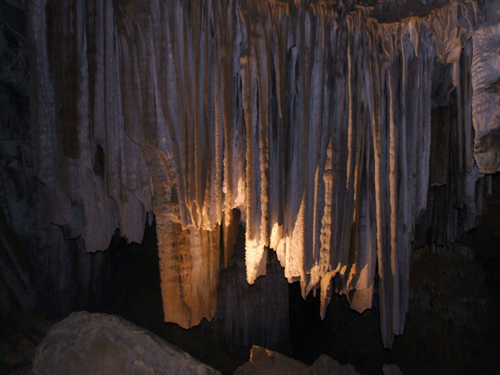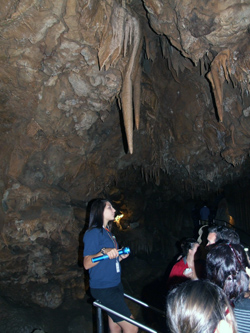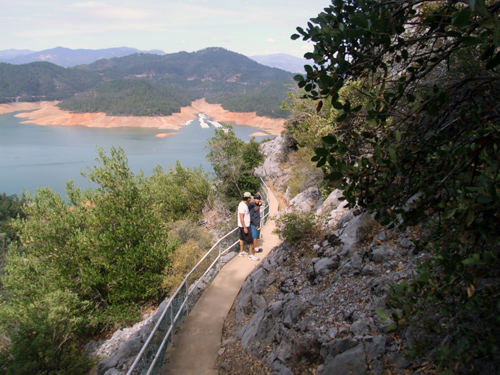
-Last of a 23-part series-
By Donald H. Harrison


LAKEHEAD, California – Melelani Correa, a high school senior working at Lake Shasta Caverns, and her fellow guides like to fantasize about the shapes made by mineral-laden water dripping onto cave walls. Somewhat food-focused, she sees the shape of chili peppers here, strips of bacon there, and elsewhere spaghetti, peanut brittle, a forest of broccoli, and a giant cupcake, among other fantasy formations. Looking at cave walls is a little bit like looking at clouds and finding stories in their shapes.
Legends about caves have been around for thousands of years, and as serious Jewish scholars will tell you, not all of them have been fantasies. Two of the most famous cave stories in Judaism concern the Machpelah, also known as the Cave of the Patriarchs, which is situated in Hebron, and Qumram, a series of caves located in cliffs overlooking the Dead Sea.
We are introduced to Machpelah in the Book of Genesis when Abraham buys the cave as a place to bury his wife Sarah. He was willing to pay 400 shekels, a very high price, to Ephron the Hittite following a very public negotiation, so there would be no question whatsoever that he owned the cave and had the right to bury Sarah there. Years later Abraham would be buried besides his wife. Next Isaac and Rachel were buried there, and, later still, Jacob and Leah. (Rebecca was buried near Bethlehem after dying in childbirth).
But why Machpelah? Abraham could have shopped around and found another cave for much less money. According to Jewish legend, he visited the cave at some time before the negotiation and found that it led him from the outer world to the inner world. According to this legend, he saw the perfectly preserved bodies of Adam and Eve lying together near the entrance to the Garden of Eden. The name Machpelah suggests this story; roughly translated it means the double tomb.
Believe that legend or not, there is plenty of historic proof to corroborate another story, the one about the eleven caves at Qumran, where beginning in 1947 the Dead Sea Scrolls – parchments dating back nearly two millennia—were found stored in some pottery that had been tucked away, perhaps by a religious group who had lived and worshiped there. The writing on some of the scrolls is so close to what is written on Torahs today that the tradition has grown up that for more than 2,000 years scribes have been able to keep the Torah absolutely intact, with not a letter out of place.
On the scripted tour of Lake Shasta Caverns led by young Correa, visitors get a sense of why caverns and caves, mysterious and beautiful as they are, have continued through the millennia to be irresistible to visitors, spelunkers, and story tellers.
As it is told, in the late 1870s, J.A. Richardson, an employee of the Bear Fish Hatchery, was hunting for bobcat in the limestone formations overlooking the McCloud River in an effort to protect the fish in the waterway.
(The hatchery today is submerged under 300 feet of water resulting from the construction in 1945 of the 602-foot high Shasta Dam across the Sacramento River. Back up caused by the dam created Lake Shasta, covering portions of the Sacramento River, Squaw River and the McCloud, and creating 400 miles of lake shore.)
After spotting an opening to a cavern, Richardson hired construction workers to blast through the entrance to enable a deeper exploration.

The first interior space seen by Richardson and fellow explorer Charles Morton was a place now named the Discovery Room, where stalactites and stalagmites, caused by mineral water drip, grew toward each other over thousands of years to form columns. How many thousands of years? Correa reported that University of California Berkeley specialists have estimated the age of the formations to be between 60,000 and 80,000 years old.
You can remember that one hanging from the top of the cave is called a stalactite because “it has to hang on tight” while one growing up from the floor of the cave is a stalagmite, because “it might make it to the top,” Correa says, quoting a well-known saying among cave explorers.
Next, our tour group was led to the Dome Room, named for its rounded “ceiling.” Correa informed us that from where we were standing to the top of the dome measured about 80 feet. She then asked if any of us worried about what would happen if there were an earthquake while we were underground.
Before any of us could answer, or get too paranoid, she informed us that “about 30 years ago we did have a 5.2 earthquake” that was felt across the lake at the gift shop. “Things were falling off the shelves and the tourists were freaking out.” In the caverns, however, “we had 85 tourists with three tour guides,” and when they emerged they were perplexed why everyone who had been outside was excitedly asking them if anyone had been hurt. The tourists who had been in the caves were utterly unaware that there had been an earthquake, she said. “Nothing shook and nothing fell.”

Onward we trekked to the “Discovery Room,” the half way mark of our tour. In all one has to climb up 600 steps during the tour, 80 of them in a narrow staircase in this vicinity. After climbing we came to the “Basement Room,” which seemed like a misnomer. After all, who goes up steps to a basement? Correa said the room was so named because when Richardson entered the room “it was the lowest room” of those discovered. The “basement” also was called the “Dead Room” because an umbrella-like obstruction up top prevents mineral waters from dripping down and creating formations.
A small chamber off to the side is called the Chimney Room. In it is a ladder that Richardson and fellow explorers used to climb to what was our last stop on the tour, the Cathedral Room, the biggest space of all, rising from its floor 150 feet to the ceiling and containing numerous formations.
“Everyone see the light up there?” asked Correa. It was through that small hole that Richardson made his way from the outside into the bowels of the cavern, she said.
And now, before our cavern tour concluded, it was again story time. Correa said there once was a group in the Lake Shasta area with members who considered themselves hardy explorers. They devised an initiation rite for new members in which 30 men participated. They were led blindfolded through the cavern to the Basement Room, and then given exactly 24 hours to get out of the cavern without assistance.

Only three men accomplished the task, said Correa. How did they do it? One gentleman suggested they followed air currents.
Right, Correa agreed. The men took off some of their clothes and burned them. Then they followed the trail of smoke to the exit.
*
IF YOU GO: We stayed at the Comfort Suites at 1195 Grand Avenue in Redding, where amenities included free wifi, a daily newspaper, and a free breakfast.
*
Harrison is editor of San Diego Jewish World. He may be contacted via donald.harrison@sdjewishworld.com